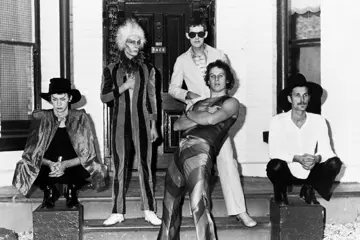EDGE OF TOMORROW

Ever wanted to watch Tom Cruise die? Then Edge Of Tomorrow is your film. Doug Liman's exo-skeletal explosion-movie has a simple, wildly-entertaining premise: Cruise is human-collateral thrown into an unwinnable war against invading aliens, who gets stuck in a time-loop. Every time he dies, the day restarts anew. It's less Groundhog Day, more video-game conceit turned narrative hook: Cruise using each 'life' to train up, advance further, inch towards the end game. His lives are limitless, but, in a neat narrative wrinkle, only if he dies every day. Which means, as viewer, you see ol' couch-jumper killed again and again. In often - intentionally! - hilarious fashion.
The first time Cruise dies - face melting in an explosion like a Lost Ark Nazi - it's shocking to see the ageless King of Dianetics the Summer Blockbuster dispatched so swiftly, with so little dignity. But after the first death is dramatic, and his 'reawakening' carries gravity, soon his every grisly demise comes with a brutal cut, and little reverence; each reset not beginning the narrative over, but continuing it apace.
Liman - who set the tempo of a great action franchise with the breathless Bourne Identity - knows that 'downtime' is inertia to the blockbuster, and keeps the pace duly rattling. Edge Of Tomorrow begins with opening credits that condense a whole saga's exposition into the space of a pop-song; and its endless hard edits can compress entire arcs into the blink of an eye. In a few key, clever moments, the smartly-penned script (written and rewritten, in a life-imitates-art fashion) leaps ahead, with Cruise going through something he's evidently experienced before, but the audience hasn't. In these moments, our hero seems all-seeing oracle, a mystic who knows everything that's about to happen (which is, surely, how TC sees himself IRL). But, mostly, he's the butt of jokes; endless micro-scenes ending with an exasperated Emily Blunt executing a hapless Cruise with a roll of her eyes.

"We never needed (or liked) that Cruise punk anyway!"
In an unexpected piece of genuine gender-inversion from the Hollywood Industrial Complex, Blunt is the one cast as traditional action-star: the perfectly-sculpted, muscle-rippled killing-machine given a hero's entrance, a flair for automatic weapons, and an ability to effortlessly escape capture. Cruise, on the other hand, is in his element as a smarmy military-PR shill, an ex-ad-exec weasel whose sweet ride ends when he's stripped of his rank and anonymously dumped in a Full Metal Jacket bootcamp presided over by Bill Paxton, a sneering Southern preacher proselytising the gospel of battle.
Over the course of several hundred lives, Cruise, of course, morphs from cowardly neophyte to world-saving super-hero (this his second straight flick, after last year's Oblivion, to end with Tommy C single-handedly saving humanity by plunging into the belly of the beast), but that journey - and the climax - has no heavy-handed moments of drama, just endless sleight-of-hand edits.
This playful approach, to both narrative and its hero, is what separates Edge Of Tomorrow from the endless ranks of identikit superhero brand-builders. It's not without its grandeur - an early 'frontlines of the war' beach-landing is visually reminiscent of both Saving Private Ryan and Gravity, with a money shot of soldiers swinging from droplines attached to a burning helicopter caught in a death spiral - but the smart-ass tone holds throughout. Like Mr. & Mrs. Smith, another Liman joint, Edge Of Tomorrow erects a tentpole action pic with the smirking subversion of a caper-comedy.

What lovely lippy you're wearing there, alien.
UNDER THE SKIN
![]()
Jonathan Glazer's remarkable Under The Skin begins with a burst of Kubrickian majesty: its opening overture an optical delight in which, with circles of blackness and light, Glazer hints at everything from pupil dilation, to interstellar travel and an alternate big bang. A picture may paint a thousand words, but these pictures are out to communicate the wordless; things that cannot be said, only felt, suggested, or dreamt. It's the astonishing opening to a film that continues to astonish until its final shot, in which rising smoke meets falling snow, and flakes land on the lens; echoing less Kubrick, Glazer's obvious filmmakin' father-figure, and more the cinematic transmigration of Michelangelo Frammartino's Le Quattro Volte. Under The Skin is a film that arises from the void, and then returns to it; cinema as the cycle of life, director as the chronicler of all creation.
It's an ambitious, career-altering work for the former video-clip wiz: a decade-in-the-making, and a clear attempt at pure auteurdom after his impressive, yet-narrative-driven work with 2000's Sexy Beast and 2004's Birth, both of which earnt admiration by rising-above the limits of their scripts. Glazer made high cinema out of marketable drama, but here the all-too-sellable premise - Scarlett Johansson as alien seductress, luring men to their deaths in frigid Scotland - actually overstates the existence of story.
Johansson arises out of the glowing orbs of opening; first via the sound of her practiced diction, life-imitating-art as her alien spirit acquires Earth language whilst the actress practices her toffee English accent. Incarnate in the human form of a Hollywood babe, Johansson's dispatched on a seduce-and-entrap mission that is fabulously low-rent: she drives around in a van, pretending to be lost, offering men rides. After the highly-stylised opening (including just-as-awe-inspiring shots of motorcycles slicing through the countryside, light rippling off their riders' visors), Glazer turns to fiction-blurring socio-realism: Johansson driving along real streets, navigating real crowds of post-football drunks, attempting to 'pull' real men, her adopted accent clashing with their rough Scottish brogues. When she finally (after much failing) lands a catch, the director shoots them Kiarostami-style: two cameras mounted on the dash, cutting the twin-shot conversation as Johansson drives.
Later, Glazer will willingly obliterate this vérité realism - layering shots of regular citizens on the streets into a psychedelic haze; a visual symphony of banal humanity - but for the film's early stretches, he's invested in it. If only to mark a stark contrast to the scenes of seduction/demise, in which Johansson's black-widow spider dance leaves striding men, cocks fabulously erect, sinking into a black liquid that entombs them like a specimen in a jar of formaldehyde, until their spirit/matter is spat onto a Matthew Barney-esque conveyer belt, in which the red slime of life funnels towards the psychedelic light-show of a red infinity.
Under The Skin is full of these vivid images; the film first and foremost a work of visual wonder. Its narrative - freely adapted from Michel Faber's unfilmable alien-underclass satire, which it barely resembles - hinges on a familiar trope of films about aliens/cyborgs/robots: a humanoid 'other' flirts with tentative humanity. Initially she's all-too-inhuman, something symbolised in another unforgettable scene: a tension-riddled, terror-of-the-oceans sequence in which she dispassionately watches a woman drown, murders her grief-wracked husband, and leaves their infant child screaming alone on the beach. Eventually, she's 'turned' by an encounter with a radically-disfigured man (Adam Pearson, public activist for those suffering neurofibromatosis), whom she picks up but lets go. Flickering feelings of conscience mark a rupture in her mission, and from there Johansson tries, and fails, to be a human; what she can functionally 'do' with her body - eating cake, having sex - disgusting her deeply. Her human turn has a gendered cost, too: after a profeminist stint as alpha-predator, when Johansson shows even a hint of weakness she's soon reduced to prey, fated to be victim to the human horrors of patriarchal violence.
Glazer uses this 'turn' to look at the world through alien eyes: to stare at the orange element of a bar-heater as if it, too, is the glowing light of eternity; to disappear into the fog as if into a void. Dirtied carpet is just as visually rich as a forest of pines bending in the wind; in front of Glazer's camera, every atom seems a miracle. Obsessed with both the infinitesimal micro and the infinite macro, Under The Skin is a film alive to tiny observations and big questions, a work of philosophical photography in which its every amazing image is open to interpretation.















